Nucleic acids Study guides, Revision notes & Summaries
Looking for the best study guides, study notes and summaries about Nucleic acids? On this page you'll find 7247 study documents about Nucleic acids.
Page 4 out of 7.247 results
Sort by
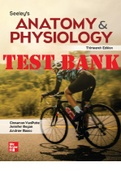
-
TEST BANK for Seeley's Anatomy & Physiology 13th Edition by Cinnamon VanPutte, Jennifer Regan, Andrew Russo. All Chapters 1-29. (Complete Download) 1751 Pages
- Exam (elaborations) • 1751 pages • 2023
- Available in package deal
-
- £14.65
- 7x sold
- + learn more
Version 1 1 CHAPTER 1 1) Which technique creates a three-dimensional dynamic image of blood vessels? A) Digital subtraction angiography B) Magnetic resonance imaging C) Dynamic spatial reconstruction D) Positron emission tomography 2) Magnetic resonance imaging is based on the movement of A) electrons in a magnetic field. B) carbons in a magnetic field. C) protons in a magnetic field. D) cells in a magnetic field. 3) The delivery of a radioactive compound to the body to study the met...
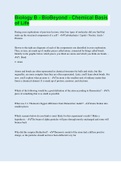
-
Biology B - BioBeyond - Chemical Basis of Life | 60 Questions with 100% Correct Answers | Updated & Verified
- Exam (elaborations) • 6 pages • 2022
- Available in package deal
-
- £5.28
- 14x sold
- + learn more
During your explorations of previous lessons, what four types of molecules did you find that make up the structural components of a cell? - Carbohydrates / Lipids / Nucleic Acids / Proteins Shown to the right are diagrams of each of the components you identified in your exploration. They, in turn, are made up of smaller pieces called atoms, connected by things called bonds. Identify in the graphic below which pieces you think are atoms and which you think are bonds. - 1. Bond 2. Atom Ato...
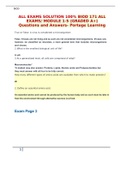
-
ALL EXAMS SOLUTION 100% BIOD 171 ALL EXAMS/ MODULE 1-5 (GRADED A+) Questions and Answers- Portage Learning
- Exam (elaborations) • 36 pages • 2022
-
- £12.03
- 5x sold
- + learn more
ALL EXAMS SOLUTION 100% BIOD 171 ALL EXAMS/ MODULE 1-5 (GRADED A+) Questions and Answers- Portage Learning True or False: A virus is considered a microorganism. False. Viruses are not living and as such are not considered microorganisms. Viruses can, however, be classified as microbes, a more general term that includes microorganisms and viruses. 2. What is the smallest biological unit of life? A cell. 3. At a generalized level, all cells are comprised of what? Macromolecules* *A...
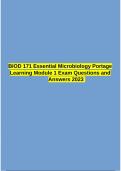
-
BIOD 171 Essential Microbiology Portage Learning Module 1 Exam Questions and Answers 2023
- Exam (elaborations) • 11 pages • 2023
-
- £9.35
- 1x sold
- + learn more
BIOD 171 Essential Microbiology Portage Learning Module 1 Exam Questions and Answers 2023 BIOD 171 M1: Module 1 Exam - Requires Respondus LockDown Browser + Webcam Question 1 3 / 3 pts True/False. A virus is classified as a microbe. Correct! True Although viruses are not living and as such are not considered microorganisms, they can, however, be classified as microbes, a more general term that includes microorganisms and viruses. False Question 2 3 / 3 pts True or False: The...
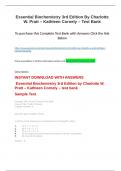
-
Essential Biochemistry 3rd Edition By Charlotte W. Pratt – Kathleen Cornely – Test Bank
- Exam (elaborations) • 24 pages • 2023
-
- £9.35
- 1x sold
- + learn more
Essential Biochemistry 3rd Edition By Charlotte W. Pratt – Kathleen Cornely – Test Bank Question type: Multiple Choice 1) Which of the following is a characteristic of Chargaff’s rules? 1. A) A + T = C + G 2. B) A + G = C + T 3. C) A + G = C + U 4. D) all organisms have identical amounts of all four nucleotides 5. E) none of the above Answer: B Difficulty: Medium Section Reference: 3-1 Learning Objective: Describe the structural features of DNA and RNA 2) A base found exclusive...
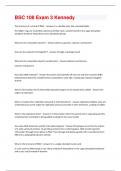
-
BSC 108 Exam 3 Kennedy Questions and Answers Solved 100% Correct!!
- Exam (elaborations) • 12 pages • 2024
- Available in package deal
-
- £6.91
- 1x sold
- + learn more
The structure of a strand of DNA. - Answer-it is a double helix, like a twisted ladder. the ladder rings are nucleotide subunits and they have a covalent bond to the sugar phosphate backbone (made of deoxyribose and a phosphate group) What are the nucleotide subunits? - Answer-adenine, guanine, cytosine, and thymine How are the subunits held together? - Answer-through a hydrogen bond What are the nucleotide subunits compliments? - Answer-Adenine and thymine cytosine and guanine How does D...
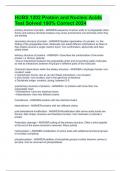
-
HUBS 1202 Protein and Nucleic Acids Test Solved 100% Correct 2024
- Exam (elaborations) • 11 pages • 2024
- Available in package deal
-
- £9.35
- + learn more
HUBS 1202 Protein and Nucleic Acids Test Solved 100% Correct 2024
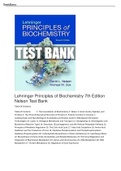
-
Test Bank for Lehninger Principles of Biochemistry 7th Edition by Nelson (complete, questions/answers/rationales) | Lehninger Principles of Biochemistry 7th Edition Nelson Test Bank
- Exam (elaborations) • 648 pages • 2023
-
- £14.62
- 2x sold
- + learn more
Lehninger Principles of Biochemistry 7th Edition Nelson Test Bank Table Of Contents Table of Contents 1. The Foundations of Biochemistry 2. Water 3. Amino Acids, Peptides, and Proteins 4. The Three-Dimensional Structure of Proteins 5. Protein Function 6. Enzymes 7. Carbohydrates and Glycobiology 8. Nucleotides and Nucleic Acids 9. DNA-Based Information Technologies 10. Lipids 11. Biological Membranes and Transport 12. Biosignaling 13. Bioenergetics and Biochemical Reaction Types 14. Glycolysis, ...
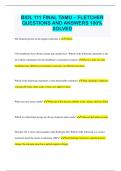
-
BIOL 111 FINAL TAMU – FLETCHER QUESTIONS AND ANSWERS 100% SOLVED
- Exam (elaborations) • 19 pages • 2023
- Available in package deal
-
- £8.13
- 1x sold
- + learn more
BIOL 111 FINAL TAMU – FLETCHER QUESTIONS AND ANSWERS 100% SOLVED The element present in all organic molecules is Carbon Cell membranes have distinct inside and outside faces. Which of the following statements is the most likely explanation for the membrane's asymmetrical nature? The two sides of a cell membrane face different environments and carry out different functions Which of the following statements is true about buffer solutions? They maintain a relatively constant pH when either aci...
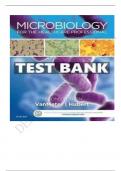
-
Microbiology for the Healthcare Professional 2nd Edition VanMeter Test Bank UPDATED & VERIFIED VERSION 2023
- Exam (elaborations) • 132 pages • 2023
- Available in package deal
-
- £16.27
- 2x sold
- + learn more
Microbiology for the Healthcare Professional 2nd Edition VanMeter Test Bank UPDATED & VERIFIED VERSION 2023 CHAPTER{01-25} Chapter 01: Scope of Microbiology VanMeter: Microbiology for the Healthcare Professional, 2nd Edition MULTIPLE CHOICE 1. In the sixteenth century a father-and-son team, by the name of , produced a compound microscope consisting of a simple tube with lenses at each end. a. van Leeuwenhoek b. Semmelweis c. Janssen d. Hooke ANS: C REF: p. 3 2. “Animalcules” were first descr...



